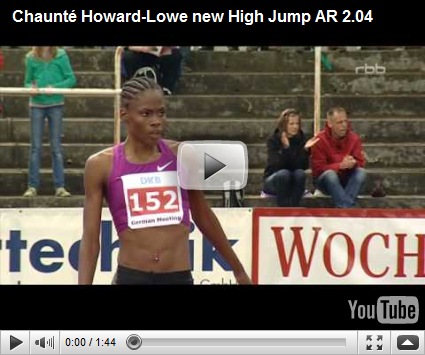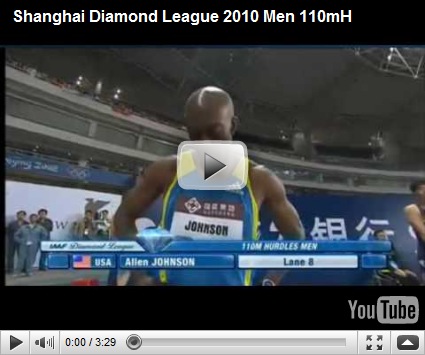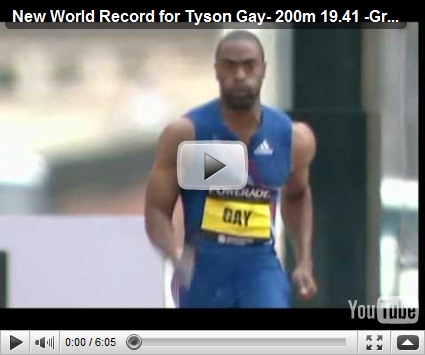For a track junkie like me the last few days have been sheer nirvana. From Thursday through last night it’s been wall to wall track and field!
Out here in California the State high school championships are just around the corner and this past week the state sectional championships were held to qualify the entrants for the State Meet! So depending on where you were it was Trials & Finals on either Thursday & Friday or Friday & Saturday. The collegiate athletes were in qualifying mode as well, as the East and West Regional Qualifiers were also held the end of the week on Thursday, Friday & Saturday. Both meets were streamed live (Thank you NCAA) so in addition to attending the local high school qualifying meet, I was also able to watch BOTH collegiate regional meets.
Then there was the Golden Spike meet in Ostrava which was streamed by Universal Sports, and then the return of the California Relays out here in Sacramento on Saturday! So it’s taken me until this afternoon to actually sit down and take a look at it all and select out the highlights – of which there were many.
The most meaningful performance has to be the American Record by Chaunte Lowe in the high jump. Jumping Saturday in Cottbus Germany, Lowe went over the bar at 6’ 8.25” (2.04m) breaking the 22 year old mark of Louise Ritter! Lowe’s mark is significant because she has been consistent so far this year right around 2 meters, so this mark is in line with where she’s been jumping and signifies that she is a legitimate contender in the event. So Lowe I believe that Lowe can safely be added to my Thirty Watch List, which has desperately looking for some additional field event strength. We will see how well she is able to maintain jumping at this level, but this puts her in range of competing against the likes of Arianne Friedrich (GER) and Blanka Vlasic (CRO).
Meanwhile Friday in Ostrava, we got some expected fast sprinting from Jamaican’s Usain Bolt and Asafa Powell. While we wait on head to head’s with Bolt, Powell, and Tyson Gay (USA) we are relegated to comparing their marks as they each run in separate meets and separate events. Bolt and Powell were both in Ostrava, just in different events, with Powell running the 100 and Bolt running a rare 300. Both were looking for records as meet organizers had timing equipment set at the 100 YARD mark as well as the 100 meter mark in Powell’s race as he was after the decades old 100 yard mark (9.21, Charlie Greene, 1967) – the event has been rarely run since 1976. Meanwhile Bolt was after Michael Johnson’s 30.85 from 2000.
Powell’s mark was almost a lock given how the 100 has evolved since the 60’s and he did not disappoint as he ran 9.09 in his heat and 9.07 in the final on his way to a WL 9.83 (-0.5) for 100 meters. Bolt just missed his mark, though his 30.97 is the #2 mark of all time. They were the best marks in a meet that saw Dayron Robles (CUB) run a seasons best 13.12 in the hurdles and David Rudisha turn in what has become a ho hum for him 1:44.03 over 800. I’m sure we’ll see something a bit more exciting from Rudisha when he locks up with Abubaker Kaki later this week in Oslo.
The real fireworks this weekend were provided by the college athletes as they ground it out for three days trying to qualify athletes & teams into the National Championship meet in Eugene, June 9 – 12. There were a lot of comments made about the changes in the qualifying process and the regional meets in particular prior to this past weekend. Having had a chance to watch them in action, I have to say that while I can understand the rationale behind the change to two regional meets, I think there needs to be some major tweaking to the system. I can discuss that another day. Today it’s about what happened at those meets and how the meet in Eugene is starting to shape up.
Looking at the two regions, everything is pretty much intact, as far as how the season looked as the teams headed outdoors from the indoor championships. The major players are all there and the teams that looked like the powers, are. So without further adieu, the highlights and comments from the NCAA Regional Qualifiers.
Western Regional – Men
Watching this regional there are some individuals, not with the power teams, that are going to be battling for individual gold and recognition. Jeshua Anderson (WaSt) heading to Eugene with a 48.65 hurdle run, Marquis Goodwin (Tx) with a 26’ 5” long jump, and Ronnie Ash (Ok) qualifying at 13.37w. All three appear to be sharp and ready to rumble in about a week and a half.
The real exciting part of the NCAA meet for me, however, is the team competition. Oregon has been in the conversation for the team championship since the first day of the outdoor season, and they gave themselves a lot of scoring opportunities by landing 16 spots to Nationals. But more and more it’s looking like they are going to have to rely heavily on Ashton Eaton and Andrew Wheating to score big points to go with lots of smaller points. At this meet Wheating – 1:46.44/3:37.52 (1500/800 double) and Eaton 26’ 4".5” (long jump) appear ready to hold up their end (with Eaton also the favorite in the decathlon), but the other members of the squad look to be vulnerable.
On the flip side, the other team emerging from this meet with a shot at the title – Texas A&M – seems to have more “sure” top points. Their two relay squads (39.05, 3:01.89); sprinters Gerald Phiri 10.17, Curtis Mitchell 10.25/20.23, Demetrius Pinder 44.93, & Tabarie Henry 45.30; and triple jumpers Tyron Stewart 54’ 5.5” & Zuheir Sharif 53’ 10.25” were very sharp here and performances like these could rack up some serious points.
Western Regional – Women
First off Lisa Koll continues to look like a sure double winner with an easy 16:28.58/34:23.64 5k/10k double – if doubling over those distances can be considered easy.
Team wise, Oregon an Texas A&M head to Nationals as co favorites in my book in a classic distance vs speed battle. The Aggie women are a sprint juggernaut as their 4x1 clocked the #2 all time collegiate performance in 42.49 #2; Jessica Beard moved on with a nice 51.35; and they qualified 3 in the 100 with Jeneba Tarmoh (11.20/22.71), Porscha Lucas (11.18/22.72), and Gaby Mayo (11.41/12.81) all doubling up nicely. They did lose hurdler Natasha Ruddock to injury, however, which could hurt their cause.
The Oregon women, at the other end of the spectrum, have a stellar 4x4 (3:30.23): qualified 3 in the 1500; and boast Anne Kesslring 2:06.71 & Keshia Baker 51.60 among their 17 entries to Eugene. They lost a strong scorer as well as Amber Purvis was a false start casualty in 200. None the less, the roles here are reversed from their male counter parts as the Oregon women are much deeper than the Aggie women. So we’ll have to wait and see how it all plays out in another week.
Eastern Regional – Men
Individually, Johnny Dutch (S. Car) made a very strong move into potential gold medal territory with a huge PR 48.12 in the 400 hurdles. He looks ready to challenge Jeshua Anderson’s two year winning streak in the event. Likewise, Rondell Sorrillo (Kentucky) 20.29 in the 200, and Kirani James (Alabama) 43.94 relay leg and 45.17 open 400, appear ready to challenge for gold.
But it’s the Florida Gator who leave here in strong position to repeat their indoor title outdoors in Eugene. While the 13 scoring opportunities they send to Eugene are slightly fewer than those of rival Oregon from the West Regional, they send more potential “big” points as both relays (38.81/3:02.75), Jeff Demps (10.06), Calvin Smith (45.06), and Christian Taylor (26’ .75”/55’ 7.5”) continue to look like gold medal possibilities. With Terrell Wilks (10.28/20.53), Omar Craddock (54’ 2.5”), Tony McQuay (45.73) and Kemel Mesic (62’ 10.5”) poised to pick up points as well, the Gators are as strong as the Oregon women are on the other side of the ledger.
The East, however, will have a lot to say about the team title as Florida State, Mississippi State and LSU all have enough sprint and relay power to make things tough for Florida, Oregon and Texas A&M. All have strong relay squads, and individuals Tavaris Tate (MsSt) 45.05, Dwight Mullings (MsSt) 45.12, Maurice Mitchell (Fl St) 10.04w20.24 have “spoiler” written on their singlets.
Eastern Regional – Women
Individually Queen Harrison (Va Tech) and Mariam Kevkhishvilli (Fl) continue to be strong favorites for titles. Harrison has lead both hurdle events all season long and continued to look strong with her 12.69/55.07 performance here. Same for Kevkhishvilli who qualified easily here throwing 57’ 10.5”.
On the team front look for perennial power LSU to make some noise in Eugene. While the Ducks and Aggies have gotten all the attention this year, the SEC champion Tigers most certainly will have a say as they send 17 scoring opportunities to Eugene. Their 4x4 (3:31.01), and sprinters Samantha Henry (11.18/23.10), Kenyanna Wilson (11.22), & Kim Duncan (23.11) along with 800 runners LaTavia Thomas (2:03.51) & Kayann Thompson (2:03.58) give LSU an opportunity to pull off an “upset” should Oregon or Texas A&M falter at all.
So, a lot of high level action this long weekend – and those are only the highlights! The sport is now in high gear. The Oslo leg of the Diamond League is in just a few days, and the NCAA Championships are just about a week away. And did I mention that the first US leg of the Diamond League – New York – is almost here? Below enjoy Chaunte Lowe’s high jump series and new AR.








